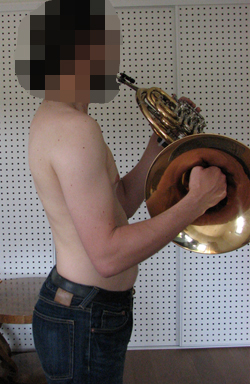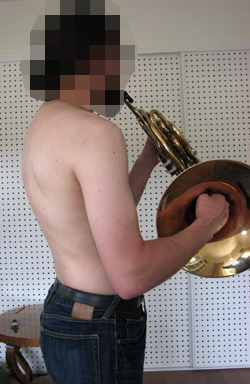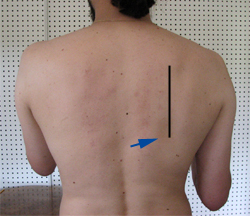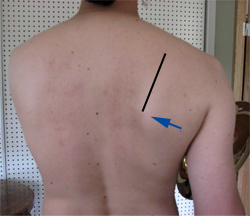French horn - harjoittelu
Käyrätorvi
Read the Ergonomics Overview first.
The body's centre position is the basic position to which the musician always returns. In the centre position, the spine maintains its natural curves. Spinal curves vary between individuals; in the centre position, the backs and hips of different people may look different.
In order to find the correct posture, horn players should first examine the position of their pelvis. The pelvis should be in the centre position so that the muscles supporting the pelvis and the spine can work freely (the ischia point directly downwards in a seated position). The French horn is a heavy instrument, and the musician needs strong shoulder blade muscles as well as good control of the midriff ! cles.
The thoracic spine should also be in the centre position to ensure the mobility of the rib cage and correct breathing. When the thoracic spine is in the centre position, the breastbone is in a vertical position and the back extensors are engaged but not tense. When inhaling, the rib cage can expand freely in all directions, including sideways and backwards. The rib cage/thoracic spine and the pelvis should be aligned when viewed from the side. If the thoracic spine tilts backwards in relation to the pelvis, rib cage and diaphragm movement is affected and consequently the musician's breathing suffers.
The centre position of the head and neck can be found by first moving the head back and forward, then leaving it in the centre position where there is free movement between the skull and the cervical spine. The position of the neck, head and jaw joints has an effect on the control of neck muscles, jaw muscles and throat muscles. The head and the neck should be in the centre position to facilitate good support for the head from the deep neck muscles. These support muscles enable the superficial muscles to relax. If the head pushes forward (often as a result of a faulty position in the lower spine), it increases tension in the neck muscles, jaw muscles and superficial neck muscles, which can affect the playing technique.
|
The pelvis and spine are in the centre position; the neck rotates to the left. |
The pelvis tilts forward, the thoracic spine curves forward; the head pushes too far forward, causing strain on the neck when the musician turns his or head to the left. |
A correct position of the thoracic spine and the rib cage enables optimal muscular support for the shoulder blades. The shoulder blades should be in a vertical position against the ribs, encouraging a natural position of the shoulders. If the shoulder blade tilts forward and/or wings off of the ribs, the shoulder blade support muscles cannot function correctly, affecting the mobility of the rib cage. The three-dimensional movement of the shoulder blade can be difficult to perceive, and the musician may require professional help during shoulder blade exercises.
French horn players are often prone to tilting their pelvis forward (the pubic bone rotates forward, causing the lumbar spine to extend). When the pelvis is rotated, the abdominal muscles relax and inhaling feels freer, but the strain on the upper limbs and the neck and shoulder area increases. When the pelvic tilt is corrected and the pelvis is in the centre position, breathing improves so that the muscles between the ribs are engaged and expand the rib cage further back and sideways. The abdomen also inflates less during inhaling.
French horn players are prone to twisting their body to the right. As a result, the thoracic spine twists, the rib joints become stiff, and the shoulder blade support deteriorates (esp. on the right-hand side). Instead of twisting the thoracic spine, a more body-friendly playing technique is to turn the cervical spine and the head further to the left, which helps to keep the body straight. The head and the neck should turn but not push forward. When the musician maintains good posture in the thoracic spine and cervical spine, the cervical spine can rotate to the left without tension in the neck muscles.
|
The shoulder blades are well supported against the rib cage, and the spine is in the centre position. |
The body twists to the right; the right-hand shoulder blade is supported insufficiently. The right-hand shoulder blade drops, wings off and tilts forward; the bottom corner! rotates towards the spine. |
The posture fault restricts the rotation of the cervical spine, increasing tension in the throat and neck muscles. To correct it, the musician needs to temporarily compromise his or her posture, slightly twisting the torso to the right and the head to the left, until his or her spinal mobility improves and the posture is corrected with the help of the exercises (older musicians may not be able to restore their full mobility).
Strong and well-coordinated shoulder blade support muscles are particularly important for French horn players; not only do they regulate the strain in the upper limbs and the neck and shoulder area, but they also have an effect on breathing. For French horn players, a typical faulty position involves dropping the shoulder blade, and/or the shoulder blade wings off of the ribs and tilts forwards, and the bottom corner rotates towards the spine. The fault is often more visible on the right-hand side of the body, as the instrument weight is supported more by the right arm (see figure 4). In order to correct the shoulder blade position, the musician needs exercises to strengthen the muscles. Faulty posture causes muscular weakness, and without strength exercises (especially for the right-hand side), finding the correct position may feel impossible. Musicians can use a temporary support (Ergohorn) to decrease the weight of the instrument during training, until the strength and control in the shoulder blade support muscles improves.
Pushing the head and neck forward is relatively common among brass musicians. The pelvis and the lumbar spine have some effect on the position. If the pelvis tilts forward, the head also pushes forward. For some musicians, pushing the head forward is pure habit. Concentrating on bringing the instrument to the lips (rather than taking the lips to the instrument) helps to maintain the neck and the head in the centre position. Mirrors are useful in eliminating incorrect movement.




